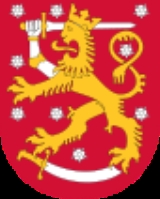
Coat of arms of Finland
Encyclopedia
The coat of arms of Finland is a crowned lion on a red field, the right forepaw replaced with an armoured hand brandishing a sword, trampling on a saber with the hindpaws. The coat of arms was originally created around the year 1580.
.png) The heraldic lion
The heraldic lion
is quite common in Western Europe
, and several European countries incorporate it into their national coats of arms. In Nordic
heraldry
, the lion is first-found in the coat of arms of Denmark
in the later part of the 12th century.
Starting in the 12th century, the territory of today's Finland
was gradually incorporated into the Swedish kingdom
, and this coincided with the period when coats of arms first came into use in northern Europe. The first known use of the lion in Sweden was on the royal seals of Erik Knutsson (died 1216) and Erik Eriksson
(1216–50), who used two and three lions on their seal, respectively. The first king of the Folkunga family
, Valdemar Birgersson (1239–1302), also used 3 lions on his seal (Figure 2).
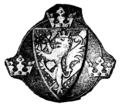
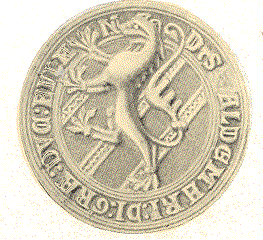 Bengt Birgersson
Bengt Birgersson
, the first Duke of Finland
(1254–91, Duke from 1284 until 1291), and Valdemar Magnusson
, the second Duke (died 1318, Duke of Finland from 1302 until 1317), both used the later Folkunga
coat of arms, which was a crowned lion rampant with three bends sinister, the main difference being that Valdemar's arms had the field strewn with hearts (Figure 3). This version of the arms was quite similar to the modern coat of arms of Finland, but the lion did not yet brandish any weapon.
assumed the title of "Grand Duke
of Finland and Karelia", soon shortened to Grand Duke of Finland in 1577 (or soon thereafter), the lion became closely associated with Finland through the grand-ducal coats of arms (Figure 5). The grand-ducal coat of arms is thought to have resulted out of a combination of the Göta lion (originating from the Folkunga lion) and the arms of Karelia
(Figure 6). The result was that the lion brandishes one weapon and treads on another.
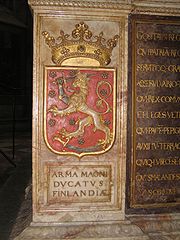
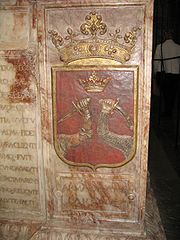 The best-known version of the grand-ducal coat of arms is found on the tomb of Gustavus I (1523–60) in the Uppsala cathedral
The best-known version of the grand-ducal coat of arms is found on the tomb of Gustavus I (1523–60) in the Uppsala cathedral
(Figure 5). It has been suggested that either Duke John himself, or his brother Eric XIV
, was leading the design work on the heraldic signs on the tomb. Neither statement can be confirmed, but it is known that Eric XIV showed an interest in heraldry. The monument was commissioned from Guillaume Boyen
(Willem Boy), a Flemish
architect and sculptor who had worked in Sweden. He started on the task in Antwerp in 1562, completing it 10 years later; however, the tomb was not in place in Uppsala until the early 1580s, and the finishing work lasted until 1591. In addition to the royal arms of Sweden and those of Finland, the arms of the 11 provinces are depicted. From Finland they include North and South Finland, as well as Tavastia
and Karelia. The work of Willem Boy is of exceptional quality, which is perhaps explained by the fact that lions were a dominant feature in the heraldry of Flanders
, and he would therefore have had a great deal of exposure to it before receiving the commission for the tomb of Gustavus I.
The earliest known blazon from this period states that the arms of Finland represents A crowned lion of gold holding a sword in the right forepaw and trampling with both hindpaws on a Russian sabre (ryssesabel), surrounded by nine silver roses in a red field, over the shield a golden crown with a red cap.
As both King Gustavus I and his son, John III, were involved in lengthy wars with Russia
, it should come as no surprise this was a central element in the arms of both the Grand Duchy of Finland, and in that in the coat of arms of the Finnish province of Karelia
, which symbolizes the fight between East
and West
.
The purpose of the nine roses remains unknown, but are now mostly considered to be decorative only. They have sometimes been claimed to represent the nine historical provinces of Finland
, but this hypothesis has not found support among prominent scholars. The number of towns in the nominal "Grand Duchy of Finland and Karelia" in 1580 were also nine, but no known historical research provides support for a link between the number of roses and the number of towns in Finland in 1580.
The lion experienced several changes during the 17th century. In the funeral banner
of Charles X Gustavus
(in 1660) it can be seen treading on the sabre
with all three free paws; in drawings by Elias Brenner (in the Suecia antique et hodierna by Erik Dahlberg
, printed in 1716), it is pictured with a double tail (queue fourchée) and with an almost walking posture.
), Erik Brenner's version of the lion was chosen by the authorities as the model for the new coat of arms of the Grand Duchy of Finland
in the Russian Empire
. The blazon
in the decree
of 26 October 1809 states: The shield has a red field, strewn with roses of silver, on which a golden lion with a crown of gold, standing on a silver saber, which it grasps with the left forepaw while holding in the right forepaw an upright sword. Obviously, any interpretation of the lion as trampling on a Russian sabre had been lost at this point in time.
During the reform of the Russian official heraldry in 1857, the lion was again changed on the initiative of baron Bernhard Karl von Köhne. The blazon states: On a red field strewn with silver roses a crowned lion of gold, holding in the right forepaw an upright sword and in the left one a curved sword on which it rests with the right hindpaw. The main changes were that the lion had started to resemble a dog
rather than a lion, and the crown on top of the shield
had been changed to an arched crown without a cap, and with a small Russian eagle
on the rim. The sword in the right forepaw had shrunk in size, to the point of resembling a dagger
rather than a sword (Figure 8).
During the years when the Russian emperors attempted russification
of Finland (1899–1905 and 1908–17), the use of the arms of Finland increased significantly, and eventually became popular in the broader population.
The director of the Finnish National Archives, Karl August Bomansson
(1827–1906) made the first significant study on the arms of Finland in modern times. He restored the appearance of the arms in 1886, so that it closely resembled the Uppsala lion. However, there was a slight deviation on how the lion tramples on the saber, and the arched crown with the imperial eagle in the von Köhne version was replaced with a crown similar to that of a German princely crown
. This version of the arms was subsequently used in the early years of Finnish independence.
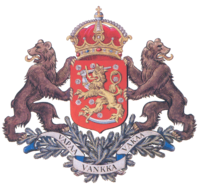 During the 1920s and 1930s, the national arms became the subject of some controversy
During the 1920s and 1930s, the national arms became the subject of some controversy
, and the debate centered on whether the lion should be replaced with a bear
, which had an important place in the national folklore
. Already in 1557, the bear had emerged as the emblem of Finnia Septentrionalis ("North Finland", at the time roughly the same as Satakunta and northern Finland Proper
) and continues to be used as the coat of arms of Satakunta. However, outside Finland, the bear was usually regarded as a symbol of Russia. The debate was however not settled, and throughout most of the 20th century, versions of the arms were used that closely adhered to the Uppsala lion.
In 1936, a state committee suggested a compromise that Finland should have a "greater" and a "smaller" coat of arms. The greater coat of arms was proposed to have two bears as supporters of the arms, with a base of spruce twigs and with the motto vapaa, vankka, vakaa ("free, firm, steadfast"). This would have given the bear a place in the national heraldry, but the design was never confirmed, nor was this version of the arms taken into use.
of the national coat of arms was finally settled in 1978, when the law of 26 May 1978 (381/78) described the coat of arms as follows: On a red field, a crowned lion, the right forepaw replaced with an armoured hand brandishing a sword, trampling on a saber with the hindpaws, the lion, crowned and armed, the weapons hilted and the armour garnished gold, the blades and the armour silver, the field strewn with nine roses of silver. (This is, however, a direct translation from Finnish; the heraldic blazon would be Gules, a lion crowned Or rampant striking with a sword Argent on his armoured dexter arm, trampling on a sabre Argent; surmounted with nine roses Argent)
The coat of arms appears on the Finnish state flag
. The Finnish lion is also used in a wide variety of emblems of different state authorities, often modified to depict the duties of the unit or the authority. On the other hand, the Finnish municipalities and regions usually use heraldic motifs drawn from elsewhere, leaving the lion for state use (exceptions exist, such as the Coat of arms of Jakobstad
). Finnish lion also appears as armed force's generals' rank insigna and in navy as part of officer's rank insigna.
The lion in Nordic heraldry
.png)
Lion (heraldry)
The lion is a common charge in heraldry. It traditionally symbolises bravery, valour, strength, and royalty, since traditionally, it is regarded as the king of beasts.-Attitudes:...
is quite common in Western Europe
Western Europe
Western Europe is a loose term for the collection of countries in the western most region of the European continents, though this definition is context-dependent and carries cultural and political connotations. One definition describes Western Europe as a geographic entity—the region lying in the...
, and several European countries incorporate it into their national coats of arms. In Nordic
Scandinavia
Scandinavia is a cultural, historical and ethno-linguistic region in northern Europe that includes the three kingdoms of Denmark, Norway and Sweden, characterized by their common ethno-cultural heritage and language. Modern Norway and Sweden proper are situated on the Scandinavian Peninsula,...
heraldry
Heraldry
Heraldry is the profession, study, or art of creating, granting, and blazoning arms and ruling on questions of rank or protocol, as exercised by an officer of arms. Heraldry comes from Anglo-Norman herald, from the Germanic compound harja-waldaz, "army commander"...
, the lion is first-found in the coat of arms of Denmark
Coat of arms of Denmark
The royal coat of arms is more complex. The shield is quartered by a silver cross fimbriated in red, derived from the Danish flag, the Dannebrog. The first and fourth quarters represent Denmark by three crowned lions passant accompanied by nine hearts; the second quarter contains two lions passant...
in the later part of the 12th century.
Starting in the 12th century, the territory of today's Finland
Finland
Finland , officially the Republic of Finland, is a Nordic country situated in the Fennoscandian region of Northern Europe. It is bordered by Sweden in the west, Norway in the north and Russia in the east, while Estonia lies to its south across the Gulf of Finland.Around 5.4 million people reside...
was gradually incorporated into the Swedish kingdom
Sweden
Sweden , officially the Kingdom of Sweden , is a Nordic country on the Scandinavian Peninsula in Northern Europe. Sweden borders with Norway and Finland and is connected to Denmark by a bridge-tunnel across the Öresund....
, and this coincided with the period when coats of arms first came into use in northern Europe. The first known use of the lion in Sweden was on the royal seals of Erik Knutsson (died 1216) and Erik Eriksson
Erik Eriksson
Erik Eriksson of Spraxkya, in Borlänge, Dalarna, , was a Swedish politician. He was the first chairman of the Centre Party, but not its founder....
(1216–50), who used two and three lions on their seal, respectively. The first king of the Folkunga family
House of Bjelbo
The House of Bjelbo , also known as the House of Folkung , was an Ostrogothian Swedish family that provided for several medieval Swedish bishops, jarls and kings.- Name and origin :...
, Valdemar Birgersson (1239–1302), also used 3 lions on his seal (Figure 2).
Finland as a duchy


Benedict, Duke of Finland
Bishop Benedict, Duke of Finland was a Swedish prelate and a royal duke.His father was Birger jarl, the real ruler of Sweden 1250-66 and Benedict was from legitimate marriage...
, the first Duke of Finland
Duke of Finland
Duke of Finland was an occasional medieval title granted as a tertiogeniture to the relatives of the King of Sweden between the 13th and 16th centuries. It included a duchy along with the feudal customs, and often meant a veritably independent principality...
(1254–91, Duke from 1284 until 1291), and Valdemar Magnusson
Valdemar, Duke of Finland
Valdemar Magnusson was a Swedish prince, heir to the throne of Sweden and Duke of Finland.-Background:Valdemar was the third son of King Magnus III of Sweden and his queen Helvig of Holstein. At the coronation of his older brother King Birger of Sweden, Valdemar became the duke of Finland...
, the second Duke (died 1318, Duke of Finland from 1302 until 1317), both used the later Folkunga
House of Bjelbo
The House of Bjelbo , also known as the House of Folkung , was an Ostrogothian Swedish family that provided for several medieval Swedish bishops, jarls and kings.- Name and origin :...
coat of arms, which was a crowned lion rampant with three bends sinister, the main difference being that Valdemar's arms had the field strewn with hearts (Figure 3). This version of the arms was quite similar to the modern coat of arms of Finland, but the lion did not yet brandish any weapon.
Creation of the arms
When John IIIJohn III of Sweden
-Family:John married his first wife, Catherine Jagellonica of Poland , house of Jagiello, in Vilnius on 4 October 1562. In Sweden, she is known as Katarina Jagellonica. She was the sister of king Sigismund II Augustus of Poland...
assumed the title of "Grand Duke
Grand Duke
The title grand duke is used in Western Europe and particularly in Germanic countries for provincial sovereigns. Grand duke is of a protocolary rank below a king but higher than a sovereign duke. Grand duke is also the usual and established translation of grand prince in languages which do not...
of Finland and Karelia", soon shortened to Grand Duke of Finland in 1577 (or soon thereafter), the lion became closely associated with Finland through the grand-ducal coats of arms (Figure 5). The grand-ducal coat of arms is thought to have resulted out of a combination of the Göta lion (originating from the Folkunga lion) and the arms of Karelia
Karelia
Karelia , the land of the Karelian peoples, is an area in Northern Europe of historical significance for Finland, Russia, and Sweden...
(Figure 6). The result was that the lion brandishes one weapon and treads on another.


Uppsala Cathedral
Uppsala Cathedral is a cathedral located centrally in the city of Uppsala, Sweden. It dates back to the late 13th century and at a height of 118.7 m is the tallest church building in Scandinavia. Originally built under Roman Catholicism and used for coronations of the Swedish monarch, since the...
(Figure 5). It has been suggested that either Duke John himself, or his brother Eric XIV
Eric XIV of Sweden
-Family and descendants:Eric XIV had several relationships before his marriage. With Agda Persdotter he had four daughters:#Margareta Eriksdotter , married 1592 to Olov Simonsson, vicar of Horn....
, was leading the design work on the heraldic signs on the tomb. Neither statement can be confirmed, but it is known that Eric XIV showed an interest in heraldry. The monument was commissioned from Guillaume Boyen
Willem Boy
Willem Boy was a Flemish painter, sculptor, and architect active in Sweden from around 1558 until his death.Few of Boy's works have survived, and he is mostly remembered for the sarcophagus of King Gustav I in the Uppsala Cathedral....
(Willem Boy), a Flemish
Flemish people
The Flemings or Flemish are the Dutch-speaking inhabitants of Belgium, where they are mostly found in the northern region of Flanders. They are one of two principal cultural-linguistic groups in Belgium, the other being the French-speaking Walloons...
architect and sculptor who had worked in Sweden. He started on the task in Antwerp in 1562, completing it 10 years later; however, the tomb was not in place in Uppsala until the early 1580s, and the finishing work lasted until 1591. In addition to the royal arms of Sweden and those of Finland, the arms of the 11 provinces are depicted. From Finland they include North and South Finland, as well as Tavastia
Tavastia (historical province)
Tavastia, Tavastland or Häme, Russian Emi or Yemi, is a historical province in the south of Finland. It borders Finland Proper, Satakunta, Ostrobothnia, Savonia and Uusimaa.- Administration :...
and Karelia. The work of Willem Boy is of exceptional quality, which is perhaps explained by the fact that lions were a dominant feature in the heraldry of Flanders
Flanders
Flanders is the community of the Flemings but also one of the institutions in Belgium, and a geographical region located in parts of present-day Belgium, France and the Netherlands. "Flanders" can also refer to the northern part of Belgium that contains Brussels, Bruges, Ghent and Antwerp...
, and he would therefore have had a great deal of exposure to it before receiving the commission for the tomb of Gustavus I.
The earliest known blazon from this period states that the arms of Finland represents A crowned lion of gold holding a sword in the right forepaw and trampling with both hindpaws on a Russian sabre (ryssesabel), surrounded by nine silver roses in a red field, over the shield a golden crown with a red cap.
As both King Gustavus I and his son, John III, were involved in lengthy wars with Russia
Russia
Russia or , officially known as both Russia and the Russian Federation , is a country in northern Eurasia. It is a federal semi-presidential republic, comprising 83 federal subjects...
, it should come as no surprise this was a central element in the arms of both the Grand Duchy of Finland, and in that in the coat of arms of the Finnish province of Karelia
Karelia
Karelia , the land of the Karelian peoples, is an area in Northern Europe of historical significance for Finland, Russia, and Sweden...
, which symbolizes the fight between East
Eastern world
__FORCETOC__The term Eastern world refers very broadly to the various cultures or social structures and philosophical systems of Eastern Asia or geographically the Eastern Culture...
and West
Western world
The Western world, also known as the West and the Occident , is a term referring to the countries of Western Europe , the countries of the Americas, as well all countries of Northern and Central Europe, Australia and New Zealand...
.
The purpose of the nine roses remains unknown, but are now mostly considered to be decorative only. They have sometimes been claimed to represent the nine historical provinces of Finland
Historical provinces of Finland
The historical provinces of Finland are a legacy of the country's joint history with Sweden. The provinces ceased to be administrative entities in 1634 when they were superseded by the counties, a reform which remained in force in Finland until 1997. The provinces remain as a tradition, but have...
, but this hypothesis has not found support among prominent scholars. The number of towns in the nominal "Grand Duchy of Finland and Karelia" in 1580 were also nine, but no known historical research provides support for a link between the number of roses and the number of towns in Finland in 1580.
Swedish era
During the following centuries, the arms of Finland were to appear in different versions of varying artistic quality, and it was only in the late 19th century when the Uppsala lion was again taken into use as the prototype for the coat of arms of Finland.The lion experienced several changes during the 17th century. In the funeral banner
Banner
A banner is a flag or other piece of cloth bearing a symbol, logo, slogan or other message. Banner-making is an ancient craft.The word derives from late Latin bandum, a cloth out of which a flag is made...
of Charles X Gustavus
Charles X Gustav of Sweden
Charles X Gustav also Carl Gustav, was King of Sweden from 1654 until his death. He was the son of John Casimir, Count Palatine of Zweibrücken-Kleeburg and Catherine of Sweden. After his father's death he also succeeded him as Pfalzgraf. He was married to Hedwig Eleonora of Holstein-Gottorp, who...
(in 1660) it can be seen treading on the sabre
Sabre
The sabre or saber is a kind of backsword that usually has a curved, single-edged blade and a rather large hand guard, covering the knuckles of the hand as well as the thumb and forefinger...
with all three free paws; in drawings by Elias Brenner (in the Suecia antique et hodierna by Erik Dahlberg
Erik Dahlberg
Count Erik Jönsson Dahlbergh was a Swedish engineer, soldier, and field marshal, called the "Vauban of Sweden".- Life :...
, printed in 1716), it is pictured with a double tail (queue fourchée) and with an almost walking posture.
Russian era
After Finland had been ceded to Russia (as a consequence of the Swedish–Russian war of 1808–1809Finnish War
The Finnish War was fought between Sweden and the Russian Empire from February 1808 to September 1809. As a result of the war, the eastern third of Sweden was established as the autonomous Grand Duchy of Finland within the Russian Empire...
), Erik Brenner's version of the lion was chosen by the authorities as the model for the new coat of arms of the Grand Duchy of Finland
Grand Duchy of Finland
The Grand Duchy of Finland was the predecessor state of modern Finland. It existed 1809–1917 as part of the Russian Empire and was ruled by the Russian czar as Grand Prince.- History :...
in the Russian Empire
Russian Empire
The Russian Empire was a state that existed from 1721 until the Russian Revolution of 1917. It was the successor to the Tsardom of Russia and the predecessor of the Soviet Union...
. The blazon
Blazon
In heraldry and heraldic vexillology, a blazon is a formal description of a coat of arms, flag or similar emblem, from which the reader can reconstruct the appropriate image...
in the decree
Decree
A decree is a rule of law issued by a head of state , according to certain procedures . It has the force of law...
of 26 October 1809 states: The shield has a red field, strewn with roses of silver, on which a golden lion with a crown of gold, standing on a silver saber, which it grasps with the left forepaw while holding in the right forepaw an upright sword. Obviously, any interpretation of the lion as trampling on a Russian sabre had been lost at this point in time.
During the reform of the Russian official heraldry in 1857, the lion was again changed on the initiative of baron Bernhard Karl von Köhne. The blazon states: On a red field strewn with silver roses a crowned lion of gold, holding in the right forepaw an upright sword and in the left one a curved sword on which it rests with the right hindpaw. The main changes were that the lion had started to resemble a dog
Dog
The domestic dog is a domesticated form of the gray wolf, a member of the Canidae family of the order Carnivora. The term is used for both feral and pet varieties. The dog may have been the first animal to be domesticated, and has been the most widely kept working, hunting, and companion animal in...
rather than a lion, and the crown on top of the shield
Shield
A shield is a type of personal armor, meant to intercept attacks, either by stopping projectiles such as arrows or redirecting a hit from a sword, mace or battle axe to the side of the shield-bearer....
had been changed to an arched crown without a cap, and with a small Russian eagle
Double-headed eagle
The double-headed eagle is a common symbol in heraldry and vexillology. It is most commonly associated with the Byzantine Empire and the Holy Roman Empire. In Byzantine heraldry, the heads represent the dual sovereignty of the Emperor and/or dominance of the Byzantine Emperors over both East and...
on the rim. The sword in the right forepaw had shrunk in size, to the point of resembling a dagger
Dagger
A dagger is a fighting knife with a sharp point designed or capable of being used as a thrusting or stabbing weapon. The design dates to human prehistory, and daggers have been used throughout human experience to the modern day in close combat confrontations...
rather than a sword (Figure 8).
During the years when the Russian emperors attempted russification
Russification
Russification is an adoption of the Russian language or some other Russian attributes by non-Russian communities...
of Finland (1899–1905 and 1908–17), the use of the arms of Finland increased significantly, and eventually became popular in the broader population.
The director of the Finnish National Archives, Karl August Bomansson
Karl Bomansson
Karl August Bomansson Karl August Bomansson Karl August Bomansson (5 April 1827 in Saltvik-7 February 1906 in Helsinki, was a Finnish historian and archivist. Between 1870 and 1883 ha was chief archivist at the National Archives of Finland. From 1862 he was associate professor in history at...
(1827–1906) made the first significant study on the arms of Finland in modern times. He restored the appearance of the arms in 1886, so that it closely resembled the Uppsala lion. However, there was a slight deviation on how the lion tramples on the saber, and the arched crown with the imperial eagle in the von Köhne version was replaced with a crown similar to that of a German princely crown
Crown (headgear)
A crown is the traditional symbolic form of headgear worn by a monarch or by a deity, for whom the crown traditionally represents power, legitimacy, immortality, righteousness, victory, triumph, resurrection, honour and glory of life after death. In art, the crown may be shown being offered to...
. This version of the arms was subsequently used in the early years of Finnish independence.
Early independence

Controversy
Controversy is a state of prolonged public dispute or debate, usually concerning a matter of opinion. The word was coined from the Latin controversia, as a composite of controversus – "turned in an opposite direction," from contra – "against" – and vertere – to turn, or versus , hence, "to turn...
, and the debate centered on whether the lion should be replaced with a bear
Bear
Bears are mammals of the family Ursidae. Bears are classified as caniforms, or doglike carnivorans, with the pinnipeds being their closest living relatives. Although there are only eight living species of bear, they are widespread, appearing in a wide variety of habitats throughout the Northern...
, which had an important place in the national folklore
Folklore
Folklore consists of legends, music, oral history, proverbs, jokes, popular beliefs, fairy tales and customs that are the traditions of a culture, subculture, or group. It is also the set of practices through which those expressive genres are shared. The study of folklore is sometimes called...
. Already in 1557, the bear had emerged as the emblem of Finnia Septentrionalis ("North Finland", at the time roughly the same as Satakunta and northern Finland Proper
Finland Proper
Finland Proper or Southwest Finland , is a region in south-western Finland. It borders the regions of Satakunta, Tavastia Proper, Ahvenanmaa and Uusimaa.- Municipalities :...
) and continues to be used as the coat of arms of Satakunta. However, outside Finland, the bear was usually regarded as a symbol of Russia. The debate was however not settled, and throughout most of the 20th century, versions of the arms were used that closely adhered to the Uppsala lion.
In 1936, a state committee suggested a compromise that Finland should have a "greater" and a "smaller" coat of arms. The greater coat of arms was proposed to have two bears as supporters of the arms, with a base of spruce twigs and with the motto vapaa, vankka, vakaa ("free, firm, steadfast"). This would have given the bear a place in the national heraldry, but the design was never confirmed, nor was this version of the arms taken into use.
Today
The blazonBlazon
In heraldry and heraldic vexillology, a blazon is a formal description of a coat of arms, flag or similar emblem, from which the reader can reconstruct the appropriate image...
of the national coat of arms was finally settled in 1978, when the law of 26 May 1978 (381/78) described the coat of arms as follows: On a red field, a crowned lion, the right forepaw replaced with an armoured hand brandishing a sword, trampling on a saber with the hindpaws, the lion, crowned and armed, the weapons hilted and the armour garnished gold, the blades and the armour silver, the field strewn with nine roses of silver. (This is, however, a direct translation from Finnish; the heraldic blazon would be Gules, a lion crowned Or rampant striking with a sword Argent on his armoured dexter arm, trampling on a sabre Argent; surmounted with nine roses Argent)
The coat of arms appears on the Finnish state flag
Flag of Finland
The flag of Finland , also called Siniristilippu , dates from the beginning of the 20th century. On a white background, it features a blue Nordic cross, which represents Christianity. The state flag has a coat of arms in the centre, but is otherwise identical to the civil flag. The swallow-tailed...
. The Finnish lion is also used in a wide variety of emblems of different state authorities, often modified to depict the duties of the unit or the authority. On the other hand, the Finnish municipalities and regions usually use heraldic motifs drawn from elsewhere, leaving the lion for state use (exceptions exist, such as the Coat of arms of Jakobstad
Coat of arms of Jakobstad
The coat of arms of the town of Jakobstad in Finland was drawn in its current form by Gustaf von Numers and portrays a red-crowned, sword-holding blue lion with a split tail. The lion is standing in a red tower in blue water...
). Finnish lion also appears as armed force's generals' rank insigna and in navy as part of officer's rank insigna.

